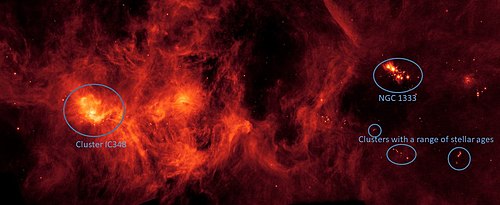This article includes a list of references, related reading, or external links, but its sources remain unclear because it lacks inline citations .(March 2021) |
| Molecular cloud | |
|---|---|
| Giant molecular cloud | |
 Map of the Perseus molecular cloud | |
| Observation data: J2000.0 [1] epoch | |
| Right ascension | 03h 35.0m [1] |
| Declination | +31° 13′ [1] |
| Distance | 956–1047 ly (293–321 [2] pc) |
| Apparent dimensions (V) | 6°×2° |
| Constellation | Perseus |
| Designations | Perseus Molecular Cloud, Perseus Cloud, Per MCld, Per Mol Cloud, Perseus Complex, PMC [1] |
The Perseus molecular cloud (Per MCld) is a nearby (~1000 ly) giant molecular cloud in the constellation of Perseus and contains over 10,000 solar masses of gas and dust covering an area of 6 by 2 degrees. Unlike the Orion molecular cloud it is almost invisible apart from two clusters, IC 348 and NGC 1333, where low-mass stars are formed. It is very bright at mid and far-infrared wavelengths and in the submillimeter originating in dust heated by the newly formed low-mass stars.
It shows a curious ring structure in maps made by the IRAS and MSX satellites and the Spitzer Space Telescope and has been detected by the COSMOSOMAS at microwave frequencies as a source of anomalous "spinning dust" emission.



